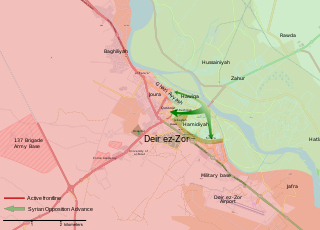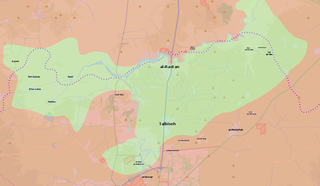Sadad is a town in Syria, 60 kilometers (37 mi) south of Homs, and 101 kilometers (63 mi) northeast of Damascus. It had over 3,500 inhabitants in the 2004 census, the majority of whom belonged to the Syriac Orthodox Church.

The Free Syrian Army is a big-tent coalition of decentralized resistance militias in the Syrian civil war founded on 29 July 2011 by Colonel Riad al-Asaad and six officers who defected from the Syrian Armed Forces. The officers announced that the immediate priority of the Free Syrian Army was to safeguard the lives of protestors and civilians from the deadly crackdown by Bashar al-Assad's security apparatus; with the ultimate goal of accomplishing the objectives of the Syrian revolution, namely, the end to the decades-long reign of the ruling al-Assad family. In late 2011, the FSA was the main Syrian military defectors group. Initially a formal military organization at its founding, its original command structure dissipated by 2016, and the FSA identity has since been used by various Syrian opposition groups.

Protests against the Syrian government and violence had been ongoing in the Syrian city of Deir ez-Zor since March 2011, as part of the wider Syrian Civil War, but large-scale clashes started following a military operation in late July 2011 to secure the city of Deir ez-Zor. The rebels took over most of the province by late 2013, leaving only small pockets of government control around the city of Deir ez-Zor.

Al-Qaryatayn, also spelled Karyatayn, Qaratin or Cariatein, is a town in central Syria, administratively part of the Homs Governorate located southeast of Homs. It is situated on an oasis in the Syrian Desert. Nearby localities include Tadmur (Palmyra) to the northeast, Furqlus to the north, al-Riqama and Dardaghan to the northwest, Mahin, Huwwarin and Sadad to the west, Qarah, Deir Atiyah and al-Nabk to the southwest and Jayrud to the south. Al-Qaryatayn translates as "the two villages".

The Battle of Ras al-Ayn was a series of armed clashes for control of the town of Ras al-Ayn during the Syrian Civil War, mainly between the Kurdish-majority People's Protection Units (YPG) and an alliance of Syrian rebel groups, with the occasional involvement of the Syrian Armed Forces. As result of the battle's first phase, the Syrian Army was expelled from the city by Syrian rebels, whereupon the latter attacked the YPG-affiliated fighters in Ras al-Ayn. In the following months, the city was effectively divided into rebel-held and YPG-held areas, with intermittent fighting resulting in the gradual expansion of the YPG's territory in the city and its surroundings. Islamist and jihadist factions soon became dominant among the rebels in the region, further contributing to tensions with the secular-leftist YPG. In July 2013, the battle's final phase erupted and ended when an alliance of YPG-led troops completely expelled the rebels from Ras al-Ayn.

The al-Qusayr offensive was an operation by the Syrian Government forces against Opposition forces at al-Qusayr in Homs province, during the Syrian Civil War. The operation was launched on 4 April 2013. The Syrian Army, the Lebanese militia Hezbollah and the National Defense Forces played key roles in the attack. Its aim was to capture all villages around the rebel-held town of al-Qusayr, thus tightening the siege of the city and ultimately launching an attack on al-Qusayr itself. The region was an important supply route for rebels fighting Syrian government forces in Homs.
The Lebanese–Syrian border clashes were a series of clashes on the Lebanon–Syria border caused by the ongoing Syrian Civil War.

Jund al-Aqsa, later known as Liwa al-Aqsa after 7 February 2017, was a Salafist jihadist organization that was active during the Syrian Civil War. Formerly known as Sarayat al-Quds, the group was founded by Abu Abdul 'Aziz al-Qatari as a subunit within the al-Nusra Front. The group later became independent, because al-Nusra was growing too rapidly for its resources and had suffered from fighting the Islamic State of Iraq and the Levant. On 20 September 2016 the U.S. Department of State designated Jund al-Aqsa as a terrorist organization. The group rejoined al-Nusra Front, by then renamed Jabhat Fateh al-Sham (JFS), in October 2016. However, on 23 January 2017, JFS declared that Jund Al-Aqsa was no longer part of Jabhat Fateh Al-Sham. In early February 2017, some of Jund al-Aqsa's units joined the newly formed Tahrir al-Sham, while the others refused and formed a new splinter group called Liwa al-Aqsa, and captured many towns in northern Hama and southern Idlib from other rebel groups. Following these attacks, Tahrir al-Sham launched a military operation against Liwa al-Aqsa, accusing them of being an ISIL affiliate. Following intense clashes with Tahrir al-Sham, up to 2,100 Liwa al-Aqsa militants left Idlib Province to join ISIL in Raqqa Province, by 22 February 2017.

The Qalamoun offensive (2014) was launched by the Syrian Army, in coordination with the Lebanese militia Hezbollah, during the Syrian Civil War against remnant rebel forces following the previous Battle of Qalamoun which resulted in the military securing all of the towns in the region.
The Deir ez-Zor offensive was executed by the Islamic State of Iraq and the Levant, also known as ISIS, against all other opposition forces in the Deir ez-Zor Governorate as part of the Inter-rebel conflict during the Syrian Civil War.

The al-Nusra Front–SRF/Hazzm Movement conflict started in late October 2014, during the Syrian Civil War, in Idlib and Aleppo governorates, during which al-Nusra attempted to establish an Islamic state rival to that of ISIL. Despite this, the al-Nusra Front and Free Syrian Army factions continued to cooperate in the southern Syrian governorates of Quneitra and Daraa.

The Battle of Yarmouk Camp (2015) broke out in April 2015, during the Syrian Civil War, when the Islamic State of Iraq and the Levant stormed the rebel-held Yarmouk Camp. The Yarmouk Camp is a district of Damascus that is home to the largest community of Palestinian refugees in Syria.
The following is a timeline of the Syrian Civil War from January to July 2015. Information about aggregated casualty counts is found at Casualties of the Syrian Civil War.
The following is a timeline of the Syrian Civil War from January to July 2014. Information about aggregated casualty counts is found at Casualties of the Syrian Civil War.
The Battle of al-Qaryatayn (2015) was a military operation launched by the Islamic State of Iraq and the Levant to capture the town of al-Qaryatayn, in August 2015, during the Syrian Civil War.

The Homs offensive from November to December 2015 was launched by Syrian government forces during the Syrian Civil War in November 2015. The objective of the operation was to recapture territory lost to ISIL, in the eastern part of the Homs Governorate, during the fall of that year.
The following is a timeline of the Syrian Civil War from January to April 2016. Information about aggregated casualty counts is found at Casualties of the Syrian Civil War.
Opposition–ISIL conflict during the Syrian Civil War started after fighting erupted between Syrian opposition groups and the Islamic State of Iraq and the Levant (ISIL). In early January 2014, serious clashes between the groups erupted in the north of the country. Opposition groups near Aleppo attacked ISIL in two areas, Atarib and Anadan, which were both strongholds of the fundamentalist Sunni organization. Despite the conflict between ISIL and other rebels, one faction of ISIL has cooperated with the al-Nusra Front and the Green Battalion to combat Hezbollah in the Battle of Qalamoun. By 2018.

The siege of Northern Homs was a siege lasting six years, by the Syrian government in the northern part of the Homs Governorate during the Syrian civil war, as a result of the rebel capture of Rastan and surrounding areas in 2012, the rebel-held pocket in northern Homs was fully taken by the Syrian government in 2018 after clearing opposition held areas around the capital.










